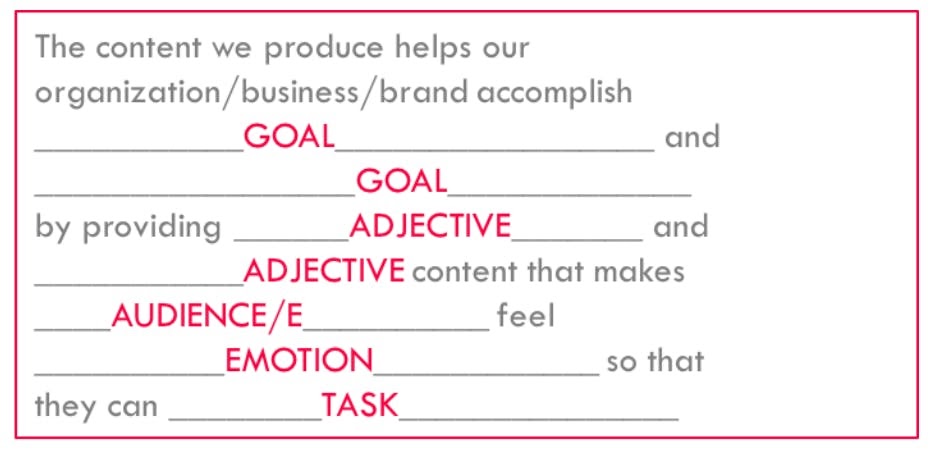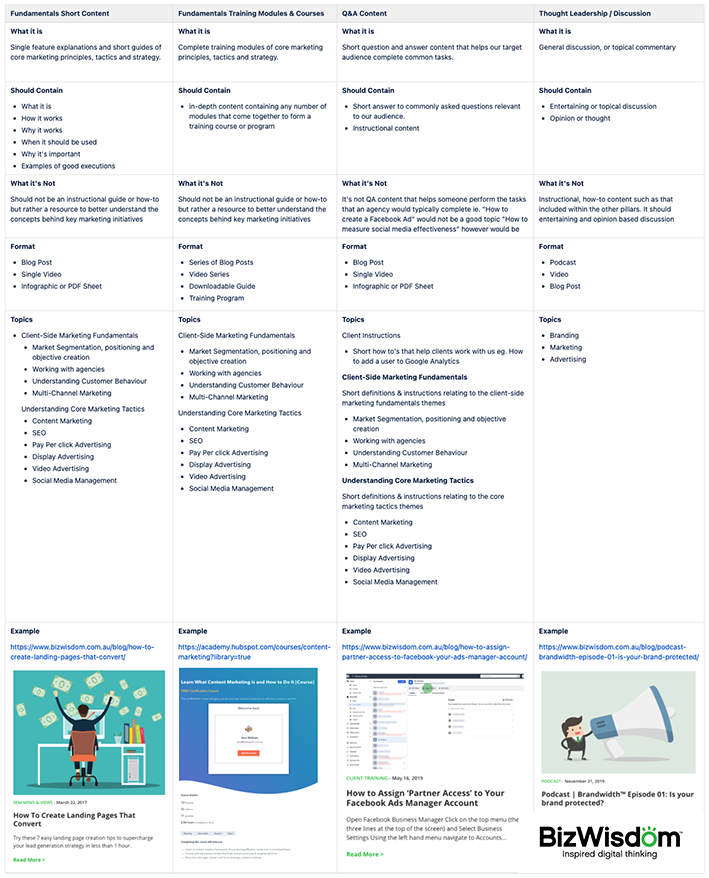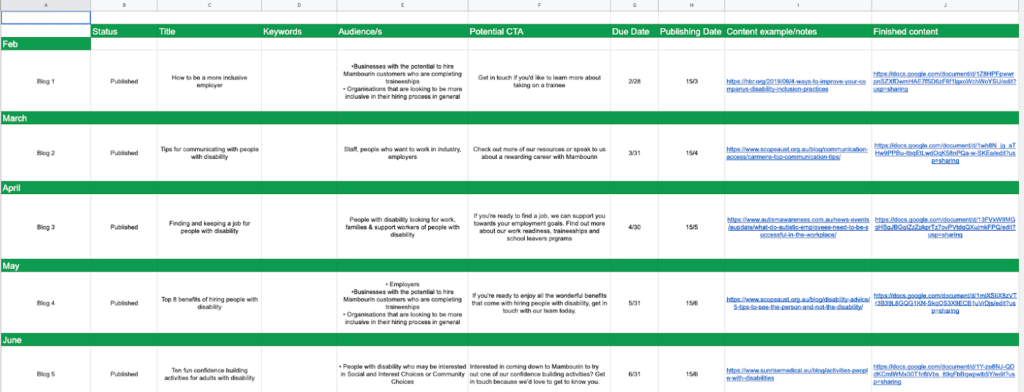
The ultimate step-by-step guide to creating a killer content plan
Did you know that despite dedicating time and resources to creating a killer content strategy, 70% of marketers fail to turn that strategy into an actionable content plan?
At its simplest, a content plan is a roadmap toward your content marketing goals, and it makes planning and executing quality content a breeze. This easy to follow guide will provide you with step-by-step instructions on how to create your own strategic content plan, including a downloadable content plan template, so that you can start organising your content production, for optimal results.
What is a content plan?
A content plan is a document that includes the essential information required to achieve the goals you’ve identified in your content marketing strategy. It contains everything you need to manage the production of your content: including writing, distributing and tracking your content.
A good content marketing plan should include your:
- Objectives
- Mission statement
- Tone of voice
- Content pillars
- Editorial calendar
Why is it important to create a content plan?
A content plan is more than just an editorial calendar (although this is a very important element). As well as defining who will be creating what pieces of content, when they will be posted and where, a content plan helps keep your content consistent, no matter who the writer is.
This is done by including your objectives, mission statement and a short description of your tone of voice in the same document as your editorial calendar. This way, your content producers can quickly and easily refer to this information to make sure their messaging is always on-brand—even if you’re using freelancers or have hired a new staff member.
A content plan is also helpful for those times when you get busy and don’t have time to come up with fresh content ideas (sound familiar?) You should have 6-12 months’ worth of content in your content plan at all times, meaning you’ll always have backup content ideas ready to be executed if you get stuck.
How to create a content plan
Okay, so it’s time to start putting together your own content plan. There are, of course, great tools available to create a content plan template, but we like to use Google Sheets because it’s free, easy to use and can be easily shared between stakeholders.
The following outlines the key elements to include within your Google Sheet (or you can scroll to the end and swipe our template to jump straight in.)
1. Define your content objectives
Your content objectives are the driving purpose behind your content plan. They are a list of objectives that align with your overall business goals. Every piece of content you create should aim to fulfil one or more of your content objectives. The most common content objectives include:
- Increase site traffic
- Generate leads
- Build retargeting audiences
- Increase brand awareness within your category
- Acquire backlinks
- Support social media initiatives
- Encourage deeper product engagement
2. Prepare an editorial mission statement
Unlike content objectives that can be universal, your editorial mission statement will be very personal to your organisation. It’s an effective tool for encapsulating the essence and purpose of your content, and your writers can always come back to it to ensure that the content they produce is aligned with the needs of your organisation.
Your editorial mission statement should be no longer than a sentence or two. One way to create your editorial mission statement is to think about the 5 W’s of content marketing.
The 5 W’s of content marketing:
- Who is my target audience?
- What actions do I want my target audience to take?
- Where should my content sit?
- When is the right time in the customer’s buyer’s journey to provide this information?
- Why am I doing this?
By understanding the who, what and why of your content, you can start to create an editorial mission statement based on the template below:

Here’s an example of a content mission statement that we created for a client in the building industry:
“At XXXXX, our content helps discerning new home builders get closer to their perfect space.
Our content provides design, location, lifestyle inspiration and practical advice for busy people with highly-tuned BS radars whilst showcasing the XXXXX difference.
We’re the trusted advisor for Melbournians who like to stand out and are proud to build a home shaped by how they live.”
Not only have we answered the who, what and why of the organisation but we’ve used the tone of voice outlined in their audience personas to capture the personality of the brand. Any of your content writers can now come back to this statement during the creative process and ask themselves whether the content they’re producing aligns with this mission statement. If it doesn’t, it’s time to go back to the drawing board.
3. Decide your tone of voice
The words you use in your content define how your audience perceives you. In other words, writing is branding, and your tone of voice is as important as the logo you choose for your website.
Creating the right tone of voice for your organisation can be a painstaking process, including extensive audience research, focus groups and competitor analysis.
For the sake of this blog, we’ll assume that you’ve already segmented your audience and created a tone of voice guideline. You don’t have to write out your entire tone of voice guideline in your content plan. Include a link to the document (or example pieces of content you’ve already created) for further reading, but keep your content plan as simple as possible. Simply pick out the keywords that your content writers can scan to make sure they’re on the right track. For example:
The EXAMPLE BRAND voice is:
• Engaging
• Progressive
• Optimistic
• Sharp
• Real
4. Create content pillars
The most simple way to describe content pillars is content themes or content buckets. Just like your tone of voice research, defining the 3 to 4 content pillars that will work best for your brand requires a lot of research, including looking at trends in your industry.
The content pillars that you choose should encompass and be consistent with your brand’s purpose, values and tone of voice. If you’re yet to define your content pillars, check out Hubspot’s amazing free tutorial on creating content pillars here.
Once you’ve decided on your content pillars, use the template below (it’s included in our free template ) to start filling in all the details of each ‘theme’ or pillar. Each pillar should include the following information:
- Name of pillar
- Customer journey stage
- A description of what the pillar is
- What that pillar content can contain
- What that pillar content cannot contain
- Content formats
- Content ideas
- Example content
Here’s how your content pillar template could look when complete:

How to create an editorial calendar
Congratulations! You’ve nearly finished creating your content plan. You should now have a thorough document that makes your expectations 100% clear to any writer who you engage to create content for you.
The final step is to create your editorial calendar. This is where you forecast into the future (we’ve found that 6-month content cycles work best) and assign content pieces for publication based on important dates or events. Your editorial calendar should include:
- Date of publication
- Assigned writer
- Status of content (Draft/Completed/Published)
- Distribution channel
- Posting cadence
- Link to article
There’s no hard and fast rule about what your editorial calendar should look like, or what it should include. You can add as many columns as you need to suit your organisation’s processes, so that your work flows as seamlessly as possible. Just make sure that all your stakeholders have access to your document and that it’s updated regularly.
Here’s an example of an editorial calendar we created for a client:

Download our simple content plan template
Now that you can see how easy it is to create a content plan download our free content plan template to start filling it in yourself. If you’d like to know more about how to use content to power your business check out our Ultimate Guide to Content Marketing.



